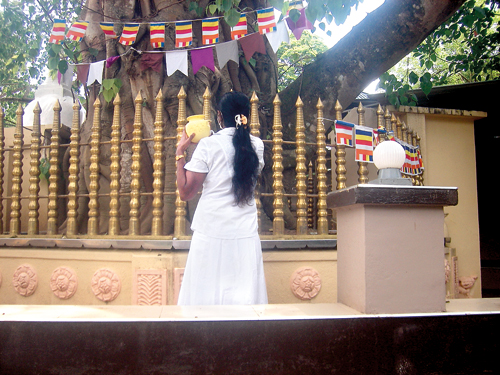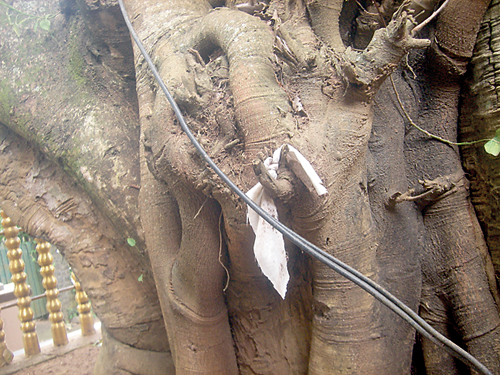Revering a Bodhi tree devoid of false beliefs

Rituals associated with Bodhi pooja
Esala Full Moon Poya falls on July 23 this year. Many significant events took place on an Esala Poya, according to Buddhist history.
Prince Siddhartha left his lay life and went forth as an ascetic in search of the Truth. Prince Rahula, his son was born on this day.
It was on an Esala Poya that the Buddha arrived at the Deer park, Varanasi to deliver the first sermon, the Dhammacakkappavattana Sutta to the five ascetics. This sutta explains the Four Noble Truths (chaturarya satya) and the Noble Eightfold Path (Ariya Atthangika Magga) – the foundation of the Buddha’s teachings.
After three months of the Buddha’s parinibbana (passing away), the first sangayanava, convocation of monks, was convened on an Esala Poya.
Many important events also took place in Sri Lanka on Esala Poya.
 King Dutugemunu laid the foundation stone for the Ruwanweli Mahaseya in Anuradhapura. Ven. Upali Maha Thera from Siam (Thailand) was invited by king Kirti Sri Rajasinha and upasampada (higher ordination of monks) was revived in Malwatu Maha Viharaya and Asgiriya Maha Viharaya in Kandy on an Esala Poya.
King Dutugemunu laid the foundation stone for the Ruwanweli Mahaseya in Anuradhapura. Ven. Upali Maha Thera from Siam (Thailand) was invited by king Kirti Sri Rajasinha and upasampada (higher ordination of monks) was revived in Malwatu Maha Viharaya and Asgiriya Maha Viharaya in Kandy on an Esala Poya.
The Vassana, the rains retreat for monks also starts every year on the day after the Esala Poya
In Bodhgaya, Bihar in India on the banks of the river Neranjana, Prince Siddhartha, the Bodhisattva seated under a Bo tree (Ficus religiosa or Peepal) in deep meditation, attained the Supreme Enlightenment (Bodhi) and became the Buddha. The tree under which he sat symbolizes wisdom and became the Bodhi Tree.
A sapling of this Bodhi Tree brought to Lanka by Ven. Sanghamitta, daughter of Emperor Ashoka and planted in Anuradhapura is considered the oldest planted tree in the world.
The original Bodhi Tree is believed to have been destroyed on many occasions, first by Tishyaraksha, Queen of Emperor Ashoka, as she did not wish Ashoka to embrace Buddhism. Although king Pushpiyamitra tried to destroy the tree, he did not succeed. The present Bodhi Tree in Bodh Gaya is a descendant of the original.
It is a very ancient tradition to believe that Devas dwelling on trees will help you if you worship them. This is perhaps the reason that devotees worship the Bodhi Tree asking for various favours. But according to the Dhamma, the Devas will protect you only if you follow the five precepts and lead a virtuous life with dana, sila, bhavana.
In the sakkanamassana sutta, it says Sakkra Deva before going on a journey was seen worshipping in different directions. Matali, his charioteer asked the Sakkra Deva, “My Lord, the Sathriyo, Sataravaram Deviyo and many other devas of higher realms worship you. What kind of beings do you worship in this manner?” Sakkra Deva replied, “Yes Matali, they all worship me. I worship those who observe high sila, practise dhamma and virtuous monks. I also worship lay devotees who give for charity, care and protect their families, who live their lives with high moral standards.” Then Matali said, “whoever you are worshipping, they are truly great. I too will worship them as you do.”(Samyutta Nikaya 11.2.8 Sakkanamassana Sutta).
Why do people worship the Bodhi tree? Most do so without understanding the true meaning of Bodhi worship. If done with proper understanding, it is good for one’s self development and peace of mind. Going near a Bodhi tree, one can experience a calm, peaceful environment to sit and meditate.
Why perform Bodhi pooja? Every human being and even animals live with feelings of insecurity.
Bahum ve saranan yanti,
pabbatani vanaani ca
arama-rukkha-cetyani,
manussa bhayatajjita
Dhammapada -188
(People driven by fear, go for refuge to many places- to hills, woods, groves, trees and shrines).
There are fears such as loss of income, losing loved ones, not getting what you desire, sickness and death. Buddha explained these as dukkha. People try to overcome these by seeking the intervention of various supernatural powers, looking for a quick remedy. Buddha has shown us a path to follow, to end the suffering in a wise and realistic way, the chaturarya satya (Four Noble Truths) and the arya atthangika magga (Noble Eight Fold Path). We chant “Budddhan saranan gachchami, dhamman saranan gachchami, sangan saranan gachchami – (we promise to understand the Buddha Dhamma and practise the Dhamma according to the teachings of the Buddha and conveyed by the Sangha).
“I will not seek any other refuge other than the Buddha Dhamma and Sangha. May these words of Truth be a blessing for me.”
These stanzas mean that we will follow the Buddha’s teaching without falling into mithya drushti (false beliefs). In Buddhism there are no superpowers that grant our wishes. We see people carrying pots of water and going round the Bodhi tree repeating stanzas and pouring the water or milk on to the tree. Flags, sometimes with names and wishes written on them, also coins in pieces of cloth are tied on to the branches. These actions will destroy the tree. Repeating stanzas in a loud voice disturbs other devotees. When in a religious place, one should control the kaya and vachanaya (body and words).
How can one perform kusal kamma (good deeds) near the Bodhi tree? Clean the area near the tree, sit in a comfortable posture, observe pansil (five precepts) and start your meditation on Buduguna bhavana, imagining the Buddha seated under the Bo tree. Then meditate on metta bhavana (loving kindness) radiating your metta to all living beings.
Buddha did not ask for any favours from the tree. He sat meditating, facing the Bodhi tree for seven days in animisalochana pooja, in gratitude for giving him shelter until he attained Enlightenment.
Buddha’s teachings are about our inner transformation, developing purity of the mind and not having attachments to the external world if one wishes to end this samsaric life.
By following the Buddha’s teaching, may you have an understanding of the true nature of life (yatharthaya) and not follow mithya drushti (false beliefs). May you be able to progress with this wisdom to become happy and peaceful until you reach the eternal happiness of Nibbana.


